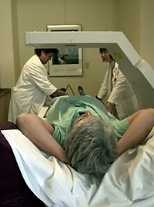Concluding a four-year process, the MIT General Clinical Research Center administratively merged with the clinical research center at Massachusetts General Hospital last month. These free-standing centers, two of the oldest clinical research centers in the country, will continue to operate separately but will be managed as one unit.
The National Institutes of Health, which fund both centers, awarded a five-year, $10 million grant to MIT in late September. This grant, part of a larger joint grant to MIT and Massachusetts General Hospital (MGH) to support the two merged clinical research centers, includes an increase over prior MIT budgets. This will make it possible to hire additional personnel.
Richard J. Wurtman, the Cecil H. Green Distinguished Professor and program director of the MIT General Clinical Research Center (GCRC) since 1985, is now associate program director of the joint enterprise. In addition to having increased staff, he's excited about new initiatives that the merge will make possible.
"Until now, our investigators have been unable to do studies involving relatively sick patients because we lack a staff of medical interns and residents. Now we can conduct such MIT protocols at the MGH," he said. "Moreover, MIT researchers lacking a medical degree should have a much easier time finding physician-collaborators." Pioneering new treatments
The GCRC was established in 1964 by Nevin Scrimshaw, head of the now-defunct Department of Nutrition and Food Science, and Hans-Lukas Teuber, head of the Department of Psychology (now Brain and Cognitive Sciences) to apply the Institute's expertise in basic science and engineering to the study of human physiology and to develop potential treatments for human diseases.
In 1990, the GCRC became part of the Harvard-MIT Division of Health Sciences and Technology (HST). The GCRC's educational activities, which include an undergraduate course in clinical investigation and UROP opportunities, are offered through HST. The center's patient-care and state licensing activities are administered through the MIT Medical Department.
The site of 60 research protocols a year, the GCRC provides the resources and environment to conduct human-based investigations in toxicology, human nutrition and metabolism, pediatrics, psychopharmacology, neuropharmacology, obesity, sleep, women's health, infectious diseases such as HIV, biomedical engineering, diabetes and neuroendocrinology.
Wurtman's own research has explored the use of Prozac to treat a severe form of premenstrual syndrome, and melatonin to treat age-related insomnia. Studies done at the GCRC led Wurtman to patent the antidepressant drug under the name Sarafem to treat premenstrual dysphoric disorder, which affects 3 to 5 percent of menstruating women in the United States. Wurtman's wife, GCRC visiting scientist Judith Wurtman, developed PMS Escape, a food-based beverage designed to manage carbohydrate cravings associated with PMS. Campus hospital
Of the 77 clinical research centers across the country, MIT's GCRC is one of only two in a university setting. Walking through the swinging doors on the fourth floor of Building E18 is like walking onto a hospital ward. There are rooms with inpatient clinical beds, outpatient treatment rooms, laboratories, a DEXA scanning instrument that measures bone density, facilities for neuropsychological testing, a core laboratory that conducts research assays on blood and urine, specialized rooms for sleep studies, a metabolic research kitchen, a patient lounge/cafeteria, handicapped-accessible showers and a nursing station right out of "General Hospital."
MIT's GCRC beds are no longer used for inpatient protocols. MGH, with its additional space and round-the-clock nursing staff, is better suited for accommodating sick patients. MIT's patients are all either healthy individuals who stop by during the day for the blood work, measurement of vital signs and other tests necessary for their particular study, or stable patients with chronic conditions such as Parkinson's disease, depression or obesity (see accompanying story).
Although MIT lacked a teaching hospital, its founders hoped the GCRC might attract M.D. or Ph.D. clinical investigators from other MIT departments as well as from collaborating Boston-area institutions, and this did in fact happen. MIT professors Emilio Bizzi, Vernon Young and others use the GCRC in their research. With the merging of the MIT and MGH centers, Wurtman expects the facility to be of even greater service to a wider range of MIT faculty.
A version of this article appeared in MIT Tech Talk on October 30, 2002.






